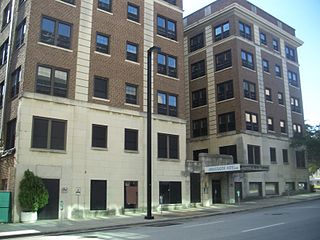
The 310 West Church Street Apartments, also known as the Ambassador Hotel, is a historic building located at 420 North Julia Street in Jacksonville, Florida, United States. On April 7, 1983, it was added to the U.S. National Register of Historic Places.
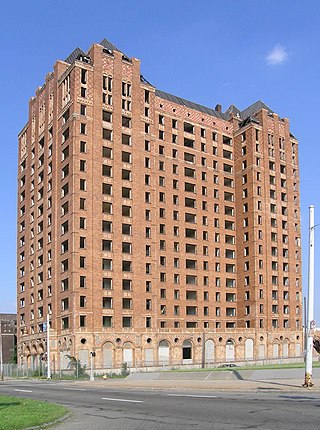
The Lee Plaza is a vacant 16-story high-rise apartment building located at 2240 West Grand Boulevard, about one mile west of New Center along West Grand Boulevard, an area in Detroit, Michigan. It is a registered historic site by the state of Michigan and was added to the United States National Register of Historic Places on November 5, 1981. Designed by Charles Noble and constructed in 1929, it rises to 16 floors and is an excellent example of Art Deco architecture of the 1920s.

The Cass–Davenport Historic District is a historic district containing four apartment buildings in Detroit, Michigan, roughly bounded by Cass Avenue, Davenport Street, and Martin Luther King, Jr. Boulevard. The district was listed on the National Register of Historic Places in 1997. The Milner Arms Apartments abuts, but is not within, the district.

The Atlanta Biltmore Hotel and Biltmore Apartments is a historic building located in Atlanta, Georgia. The complex, originally consisting of a hotel and apartments, was developed by William Candler, son of Coca-Cola executive Asa Candler, with Holland Ball Judkins and John McEntee Bowman. The original hotel building was converted to an office building in 1999. The building is currently owned by the Georgia Institute of Technology and is adjacent to Technology Square.
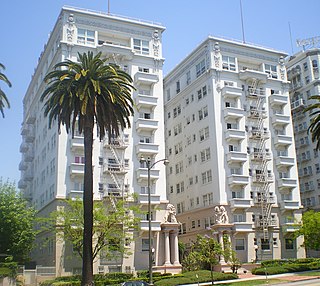
The Bryson Apartment Hotel is a historic 110,000-square-foot (10,000 m2), ten-story apartment building on Wilshire Boulevard in the MacArthur Park section of Los Angeles, California. Built in 1913 in the Beaux Arts style, it was one of the most luxurious residential buildings in Los Angeles for many years. The building is also closely associated with the city's film noir history, having been featured in Raymond Chandler's works and the 1990 neo-noir The Grifters. The building's stone lions and large rooftop "Bryson" sign have become Los Angeles landmarks. It was added to the National Register of Historic Places in 1983 and designated a Historic Cultural Monument (#653) by the Los Angeles Cultural Heritage Commission in 1998.

William Lee Stoddart (1868–1940) was an architect who designed urban hotels in the Eastern United States. Although he was born in Tenafly, New Jersey, most of his commissions were in the South. He maintained offices in Atlanta and New York City.
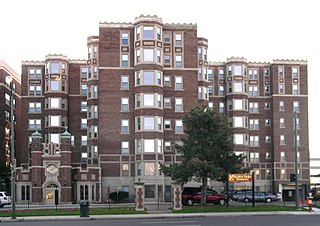
The Alden Park Towers consists of a compound of four eight-story luxury apartment buildings located at 8100 East Jefferson Avenue along the Gold Coast in Detroit, Michigan. It is currently known as Alden Towers. The collective of structures was listed on the National Register of Historic Places in 1985.

The River Terrace Apartments is an apartment building located at 7700 East Jefferson Avenue in Detroit, Michigan. It was listed on the National Register of Historic Places in 2009. River Terrace Apartments was one of the first two garden apartment complexes built in Michigan which used loan guarantees from the Federal Housing Administration, the other being Hillcrest Village in East Lansing.

The Park House Hotel, also known as St. Agatha's Seminary and Burkeley Apartments, is a historic building located in Iowa City, Iowa, United States. The building was built in 1852 for Ferdinand Haberstroh. As the Park House Hotel, it catered to those who did business when the city was the capitol of Iowa, and it is one of the few remaining commercial buildings from that era. After Haberstroh died in 1860, the Rev. William Emonds of near-by St. Mary's Catholic Church bought the property and its debt. Two years later the Sisters of Charity of the Blessed Virgin Mary from Dubuque, Iowa opened St. Agatha's Female Seminary. The building acquired its mansard roof in 1875. Classrooms were located on the first two floors and residential space for the sisters and students who boarded here were on the upper two floors. The school closed in 1909 and Albert Burkeley converted the building into a women's boarding house called "Svendi". After 1918 it became an apartment building known as "Burkeley Place", and it has been an apartment building ever since.
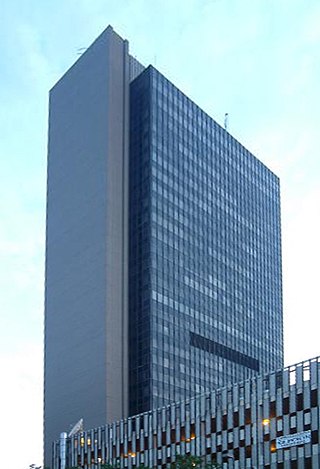
Tower on the Maumee is a skyscraper at 200 North Saint Clair Street in Toledo, Ohio. Constructed in 1969, the 400 feet (120 m) building is an example of the international style of architecture. In 2012, the building was listed on the National Register of Historic Places under the name "Riverview".
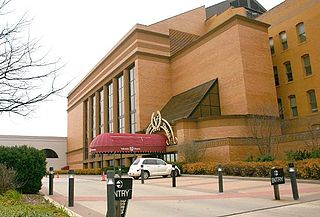
The Valentine Theatre is located in the downtown district of Toledo, Ohio at the corner of Superior and Adams Streets. The 128-year-old facility seats 901.
Alfred A. Hahn (1890–1964) was an architect in Toledo, Ohio, and the founder of the Hahn and Hayes architectural firm. He designed the United States Post Office in Oberlin, Ohio (1934) in neoclassical architecture style. It was dedicated in 1933. The contract for the post office in Oberlin was $85,000.

The Oliver House is a historic hotel building in Toledo, Ohio, designed by the architect Isaiah Rogers and opened in 1859. It was converted to industrial use in the 20th century and is now home to the Maumee Bay Brewing Company and its brew pub, as well as a patisserie, restaurants, event spaces, a theater company, art gallery, and residential apartments. It is listed on the National Register of Historic Places. as Successful Sales.

The Hotel Blackhawk is an eleven-story brick and terra cotta building located in Downtown Davenport, Iowa, United States. It is a Marriott Autograph Collection property.

The Fraser Mansion is a building at 1701 20th Street NW, at the intersection of Connecticut Avenue, 20th Street, and R Street in the Dupont Circle neighborhood of Washington, D.C. constructed in 1890 to be the George S. Fraser mansion, it served as his private residence for five years, a restaurant, a boarding house, the home of the new Founding Church of Scientology, and—currently—the location of Scientology's National Affairs office.

The Mississippi Lofts and Adler Theatre is an apartment building and theater complex located in downtown Davenport, Iowa, United States. It is individually listed on the National Register of Historic Places by its original name, the Hotel Mississippi and RKO Orpheum Theater. The Hotel Mississippi was listed on the Davenport Register of Historic Properties in 2005. In 2020 the complex was included as a contributing property in the Davenport Downtown Commercial Historic District.

The Patrick Henry Hotel is a Colonial Revival former hotel listed on both the National Register of Historic Places and the Virginia Landmarks Register in Downtown Roanoke, Virginia, United States. Located at 617 South Jefferson Street at the southern end of Downtown, the Patrick Henry was designed by William Lee Stoddart and opened in 1925. The building now serves as apartments, office space, and a restaurant in the former lobby rebranded simply The Patrick Henry. It is located in the Roanoke Downtown Historic District.

The John Jacob Astor Hotel, originally known as the Hotel Astoria, is a historic former hotel building located in Astoria, Oregon, United States, and listed on the National Register of Historic Places (NRHP). It is one of the tallest buildings on the Oregon Coast and is a "prominent landmark" in Astoria. Constructed in 1922–23, the hotel opened in 1924 and initially was the city's social and business hub, but soon was beset with a variety of problems, and struggled financially for years. It was renamed the John Jacob Astor Hotel in 1951, but a decline in business continued, as did other problems. The building was condemned by the city for safety violations in 1968 and sat vacant for several years until 1984, when work to renovate it and convert it for apartments began. It reopened as an apartment building in 1986, with the lowermost two floors reserved for commercial use. The building was listed on the NRHP in 1979. The world's first cable television system was set up in 1948 using an antenna on the roof of the Hotel Astoria.

The Humble Oil Building, is a historic office building, designed in the Italian Renaissance architecture style, located at 1212 Main Street in Houston, Texas and listed on the National Register of Historic Places. It was constructed by Humble Oil and Refining Company in 1921. The tower section was added on to the building in 1936. The building complex served as the company headquarters for Humble Oil and Refining Company from 1921 until 1963, when the company moved into what is now the ExxonMobil Building at 800 Bell Street. In 2003, the building complex was renovated for use as a combination hotel and apartments, the apartment section was converted to additional hotel rooms in 2015.

The Prince Charles Hotel is a historic hotel building located at Fayetteville, Cumberland County, North Carolina.





















